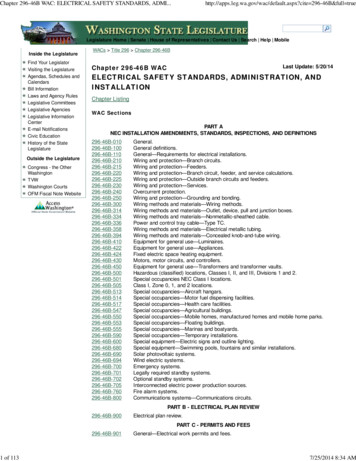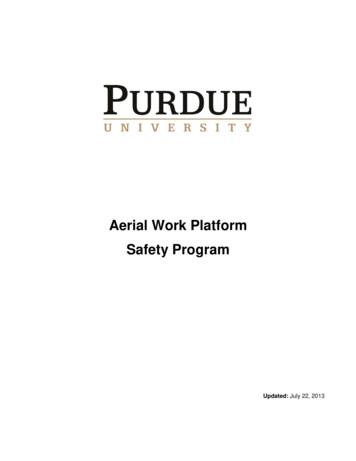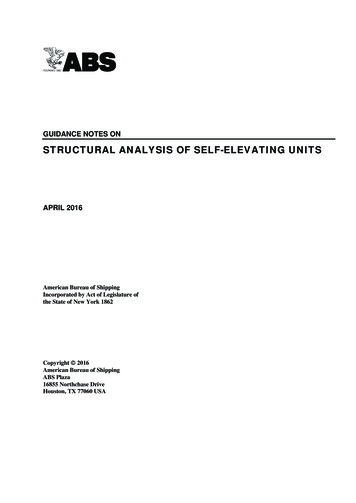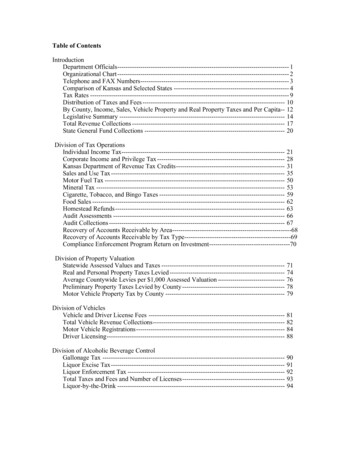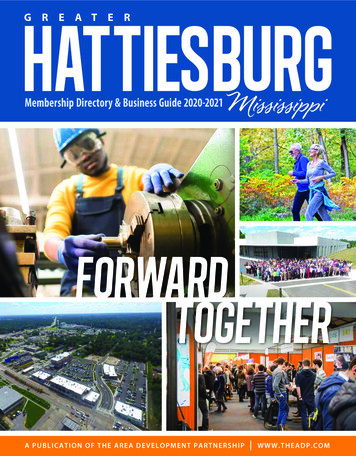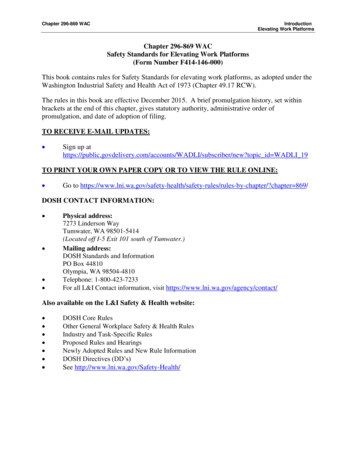
Transcription
Chapter 296-869 WACIntroductionElevating Work PlatformsChapter 296-869 WACSafety Standards for Elevating Work Platforms(Form Number F414-146-000)This book contains rules for Safety Standards for elevating work platforms, as adopted under theWashington Industrial Safety and Health Act of 1973 (Chapter 49.17 RCW).The rules in this book are effective December 2015. A brief promulgation history, set withinbrackets at the end of this chapter, gives statutory authority, administrative order ofpromulgation, and date of adoption of filing.TO RECEIVE E-MAIL UPDATES: Sign up bscriber/new?topic id WADLI 19TO PRINT YOUR OWN PAPER COPY OR TO VIEW THE RULE ONLINE: Go to rules-by-chapter/?chapter 869/DOSH CONTACT INFORMATION: Physical address:7273 Linderson WayTumwater, WA 98501-5414(Located off I-5 Exit 101 south of Tumwater.)Mailing address:DOSH Standards and InformationPO Box 44810Olympia, WA 98504-4810Telephone: 1-800-423-7233For all L&I Contact information, visit https://www.lni.wa.gov/agency/contact/Also available on the L&I Safety & Health website: DOSH Core RulesOther General Workplace Safety & Health RulesIndustry and Task-Specific RulesProposed Rules and HearingsNewly Adopted Rules and New Rule InformationDOSH Directives (DD’s)See http://www.lni.wa.gov/Safety-Health/
Chapter 296-869 WACTable of ContentsElevating Work PlatformsChapter 296-869 WACSafety Standards for Elevating Work PlatformsWACPageWAC 296-869-099 Definitions. . 1WAC 296-869-100 Scope. . 3WAC 296-869-200 Section contents. . 4Summary. 4WAC 296-869-20005 Design and construction. . 4WAC 296-869-20010 Modifications. . 5WAC 296-869-20015 Owned, rented, or leased aerial lifts. . 5WAC 296-869-20020 Operator requirements. . 5WAC 296-869-20025 Operator training. . 5WAC 296-869-20030 Operator prestart inspection. . 6WAC 296-869-20035 Workplace survey. . 7WAC 296-869-20040 Before and during use. . 7WAC 296-869-20045 Working from the platform. . 7WAC 296-869-20050 Moving the aerial lift. . 7WAC 296-869-20055 Aerial ladders. . 8WAC 296-869-300 Section contents. . 9Summary. 9WAC 296-869-30005 Manually propelled elevating work platforms. . 9WAC 296-869-30010 Self-propelled elevating work platforms. . 10WAC 296-869-30015 Boom-supported elevating work platforms. . 10WAC 296-869-30020 Modifications. . 11WAC 296-869-400 Section contents. . 12Summary. 12WAC 296-869-40005 Condition. . 12WAC 296-869-40010 Inspections. . 12WAC 296-869-40015 Repairs and adjustments. . 14WAC 296-869-40020 Manufacturer's safety bulletins. . 14WAC 296-869-40025 Inspection and repair records. . 14WAC 296-869-40030 Fueling and battery charging. . 15Page i
Chapter 296-869 WACTable of ContentsElevating Work PlatformsWAC 296-869-500 Section contents. . 16Summary. 16WAC 296-869-50005 Operator authorization and training. . 16WAC 296-869-50010 Specific model training. . 16WAC 296-869-50015 Operator training records. . 17WAC 296-869-600 Section contents. . 18Summary. 18WAC 296-869-60005 Intended use. . 18WAC 296-869-60010 Workplace survey. . 19WAC 296-869-60015 Hazardous locations. . 19WAC 296-869-60020 Set up. . 22WAC 296-869-60025 Travel speed. . 22WAC 296-869-60030 Driving. . 23WAC 296-869-60035 Elevating and lowering the platform. . 23WAC 296-869-60040 Working from the platform. . 24WAC 296-869-60045 Malfunctions or unsafe conditions. 24Page ii
Chapter 296-869 WACElevating Work PlatformsWAC 296-869-099 Definitions.Aerial device. A vehicle-mounted device, telescoping or articulating, or both, which is used toposition personnel.Aerial ladder. A vehicle-mounted elevating work platform consisting of a single or multiplesection extensible ladder. It may or may not have a platform at the top.Aerial lift. An aerial device mounted on a vehicle such as a truck, trailer, or all-terrain vehicle.Approved. Listed or approved by a nationally recognized testing laboratory or a federal agencythat issues approvals for equipment such as the Mine Safety and Health Administration (MSHA);the National Institute for Occupational Safety and Health (NIOSH); Department ofTransportation; or U.S. Coast Guard, which issue approvals for such equipment.Articulating-boom work platform. A vehicle-mounted elevated work platform with 2 or morehinged boom sections.Boom-supported elevating work platform. A self-propelled, integral chassis, elevating workplatform with a boom-supported platform that can be positioned completely beyond the base.Chassis. The part of a nonvehicle-mounted elevating work platform that provides mobility andsupport for the elevating assembly and platform.Elevating work platform. A device used to position personnel, along with their necessary toolsand materials, at work locations. It includes a platform and an elevating assembly. It may bevehicle-mounted or have an integral chassis for mobility and as a means of support.Extensible-boom work platform. A vehicle-mounted elevating work platform with a telescopicor extensible boom.Manually propelled elevating work platform. A manually propelled, integral chassis,elevating work platform with a platform that cannot be positioned completely beyond the base.Platform. The portion of an elevating work platform intended to be occupied by personnel. Itmay also be called a basket, bucket, stand, or similar term.Rated capacity. The designed carrying capacity of the elevating work platform as specified bythe manufacturer.Self-propelled elevating work platform. A self-propelled, integral chassis, elevating workplatform with a platform that cannot be positioned completely beyond the base.Type designation. A code to identify types of elevating work platforms. It is used to determineif an elevating work platform can be used in a specific classified or unclassified location. Anunclassified location is an area that is not designated as a Class 1, 2, or 3 location(a)D refers to elevating work platforms that are diesel-engine-powered that have minimumsafeguards against inherent fire hazards.(b)DS refers to diesel-powered elevating work platforms that, in addition to meeting allthe requirements for type D elevating work platforms, are provided with additionalsafeguards to the exhaust, fuel and electrical systems.(c)DY refers to diesel-powered elevating work platforms that have all the safeguards of theDS elevating work platforms and, in addition, any electrical equipment is completelyenclosed. They are equipped with temperature-limitation features.Page 1
Chapter 296-869 WACElevating Work Platforms(d)E refers to electrically powered elevating work platforms that have minimum acceptablesafeguards against inherent fire hazards.(e)ES refers to electrically powered elevating work platforms that, in addition to all of therequirements for the E elevating work platforms, have additional safeguards to theelectrical system to prevent emission of hazardous sparks and to limit surfacetemperatures.(f)EE refers to electrically powered elevating work platforms that, in addition to all of therequirements for the E and ES type elevating work platforms, have their electric motorsand all other electrical equipment completely enclosed.(g)EX refers to electrically powered elevating work platforms that differ from E, ES, or EEtype elevating work platforms in that the electrical fittings and equipment are designed,constructed, and assembled to be used in atmospheres containing flammable vapors ordusts.(h)G refers to gasoline-powered elevating work platforms that have minimum acceptablesafeguards against inherent fire hazards.(i)GS refers to gasoline-powered elevating work platforms that are provided with additionalexhaust, fuel, and electrical systems safeguards.(j)LP refers to liquefied-petroleum-gas-powered elevating work platforms that, in additionto meeting all the requirements for type G elevating work platforms, have minimumacceptable safeguards against inherent fire hazards.(k)LPS refers to liquefied-petroleum-gas-powered elevating work platforms that, in additionto meeting the requirements for LP type elevating work platforms, have additionalexhaust, fuel, and electrical systems safeguards.Vertical tower. A vehicle-mounted elevating work platform having a platform that can beraised along a vertical axis.Page 2
Chapter 296-869 WACElevating Work PlatformsWAC 296-869-100 Scope.This chapter applies to the following types of elevating work platforms:(1)Aerial lifts;(2)Manually propelled elevating work platforms that have a platform that cannot be positionedcompletely beyond the base;(3)Self-propelled elevating work platforms that have a platform that cannot be positionedcompletely beyond the base;(4)Boom-supported elevating work platforms that have a boom-supported platform that can bepositioned completely beyond the base.EXEMPTION:This chapter does not apply to elevating work platforms used:1.2.By the fire services for fire combat that are covered by Safety Standardsfor Firefighters, Chapter 296-305 WAC; orFor agriculture activities covered by Safety Standards for Agriculture,Chapter 296-307 WAC.Page 3
Chapter 296-869 WACElevating Work PlatformsWAC 296-869-200 Section contents.SummaryImportant:This section applies to the following types of vehicle-mounted aerial devices:1.2.3.4.5.Extensible-boom work platforms;Articulating-boom work platforms;Vertical towers;Aerial ladders;A combination of any of the above types of elevating work platforms.Your responsibility: To meet these requirements when using aerial lifts.You must meet the requirementsin this sectionDesign and constructionWAC 296-869-20005ModificationsWAC 296-869-20010Owned, rented, or leased aerial liftsWAC 296-869-20015Operator requirementsWAC 296-869-20020Operator trainingWAC 296-869-20025Operator prestart inspectionWAC 296-869-20030Workplace surveyWAC 296-869-20035Before and during useWAC 296-869-20040Working from the platformWAC 296-869-20045Moving the aerial liftWAC 296-869-20050Aerial laddersWAC 296-869-20055WAC 296-869-20005 Design and construction.(1)You must make sure aerial lifts manufactured on or after July 1, 2006, meet the design andconstruction requirements of ANSI A92.2-2001, American National Standard for VehicleMounted Elevating and Rotating Aerial Devices.(2)You must make sure aerial lifts manufactured before July 1, 2006, meet the design andconstruction requirements of ANSI A92.2-1969, American National Standard for VehicleMounted Elevating and Rotating Work Platforms.Page 4
Chapter 296-869 WACElevating Work PlatformsWAC 296-869-20010 Modifications.You must have written approval from the manufacturer before making any modification oraddition that affects the safe operation, stability, intended use, or the mechanical, hydraulic, orelectrical integrity of the aerial lift. Make sure the modified aerial lift is:(1)At least as safe as it was before being modified; and(2)Any change to the insulated portion of the aerial lift does not reduce the insulating value.Note: If the original manufacturer is no longer in business, an equivalententity such as a nationally recognized testing laboratory may approvemodification.WAC 296-869-20015 Owned, rented, or leased aerial lifts.Important:This section applies if you own, rent, or lease an aerial lift.(1)You must meet the requirements of the Responsibilities of Owners, section 8, of ANSIA92.2-2001, American National Standard for Vehicle-Mounted Elevating and RotatingAerial Devices, if you own an aerial lift.(2)You must meet the requirements of the Responsibilities of Renters, Lessors or Lessees,section 11, of ANSI A92.2-2001, American National Standard for Vehicle-MountedElevating and Rotating Aerial Devices, if you rent or lease an aerial lift.WAC 296-869-20020 Operator requirements.You must permit only trained and authorized personnel to operate aerial lifts.WAC 296-869-20025 Operator training.(1)You must make sure personnel are trained before they are permitted to operate an aeriallift.(2)You must cover at least the following items:(a)General instruction on the inspection, application, and operation of aerial lifts.Include recognizing and avoiding hazards associated with their operation.(b)Purpose and use of manuals. Include proper storage of the manuals on the vehiclewhen not in use.(c)Prestart inspection.(d)Responsibilities associated with problems or malfunctions affecting the operation ofthe aerial lift.(e)Factors affecting stability.(f)Purpose of placards and decals.Page 5
Chapter 296-869 WACElevating Work Platforms(g)Workplace survey.(h)Safety rules and regulations pertinent to the industry.(i)Authorization to operate an aerial lift.(j)Operator warnings and instructions.(k)Proper use of personal fall protection equipment.(3)You must have operator trainees actually operate the aerial lift, under the direction of aqualified person, for enough time to demonstrate proficiency.(4)You must retrain an operator if evaluation and observation of the operator indicatesretraining is necessary.(5)You must instruct operators in all of the following before they are directed to operate anaerial lift with which they are not familiar:(a)Location of the manuals;(b)Purpose and function of all controls;(c)Safety devices and operating characteristics specific to the aerial lift.WAC 296-869-20030 Operator prestart inspection.(1)You must make sure the operator does a prestart inspection of the aerial device as shown inTable 1, Operator Prestart Inspection.(2)You must have a qualified person examine or test any items found during the inspectionthat are thought to be unsafe, to determine if they constitute a safety hazard.(3)You must replace or repair all unsafe items before use.Table 1 Operator Prestart InspectionComponent or system:Test or inspect for the following:Operating controls and associatedmechanismsConditions interfering with properoperationVisual and audible safety devicesMalfunctionsHydraulic or pneumatic systemsVisible deterioration or excessive leaksFiberglass and other insulatingcomponentsVisible damage or contaminationOperational and instructional markingsThat they are present and legibleElectrical systems of or related to theaerial deviceMalfunction and for signs of excessivedeterioration, dirt, and moistureaccumulationLocking devices, bolts, pins, and otherfastenersThat they are in-place and not loose ordeformedPage 6
Chapter 296-869 WACElevating Work PlatformsWAC 296-869-20035 Workplace survey.You must have the operator survey the area, before using an aerial lift, for hazards such as:(1)Untamped earth fills;(2)Ditches;(3)Drop-offs and floor obstructions;(4)Debris;(5)Overhead obstructions and electrical conductors;(6)Weather conditions;(7)Unauthorized persons in the area.WAC 296-869-20040 Before and during use.(1)You must set the brakes and make sure outriggers, when used, are positioned on pads or asolid surface.(2)You must install wheel chocks when using the aerial lift on an incline if they can beinstalled safely.WAC 296-869-20045 Working from the platform.(1)You must make sure boom and platform load limits specified by the manufacturer are notexceeded.(2)You must make sure persons stand firmly on the floor of the platform and do not:(a)Sit or climb on the edge of the platform; or(b)Use guardrails, planks, ladders, or any other device to gain additional height or reach.(3)You must prohibit wearing climbers when working from the platform.(4)You must make sure all persons on the platform wear a full body harness with a lanyardattached to either:(5)(a)The manufacturer's recommended attachment point; or(b)The boom or platform if the manufacturer does not specify an attachment point.You must never attach a lanyard to an adjacent pole, structure, or equipment.WAC 296-869-20050 Moving the aerial lift.You must make sure the boom is properly cradled and the outriggers are in the stowed positionbefore moving the aerial lift.EXEMPTION:The aerial lift may be moved with the boom elevated and personnel on theplatform only if the equipment was specifically designed for this type ofoperation.Page 7
Chapter 296-869 WACElevating Work PlatformsWAC 296-869-20055 Aerial ladders.(1)You must secure aerial ladders in the lower traveling position, using the locking device orother means provided by the manufacturer, before moving it for highway travel.(2)You must make sure all persons working from an aerial ladder wear a full body harness andlanyard attached to either:(a)The manufacturer's recommended attachment point; or(b)The ladder rail if the manufacturer does not specify an attachment point.Page 8
Chapter 296-869 WACElevating Work PlatformsWAC 296-869-300 Section Contents.SummaryImportant:This section applies to manually propelled, self-propelled, and boom-supportedelevating work platforms.Your responsibility: To make sure elevating work platforms meet these design, construction,and equipment requirements.You must meet the requirementsin this sectionManually propelled elevating work platformsWAC 296-869-30005Self-propelled elevating work platformsWAC 296-869-30010Boom-supported elevating work platformsWAC 296-869-30015ModificationsWAC 296-869-30020WAC 296-869-30005 Manually propelled elevating work platforms.Important:This section applies to manually propelled, integral chassis, elevating workplatforms with a platform that cannot be positioned completely beyond thebase.(1)You must make sure manually propelled elevating work platforms meet the design andconstruction requirements of American National Standards Institute (ANSI) A92.3-1990,American National Standard for Manually Propelled Elevating Aerial Platforms.(2)You must make sure the manufacturer provides instructions and markings that meet therequirements of ANSI A92.3-1990, American National Standard for Manually PropelledElevating Aerial Platforms, on each elevating work platform.(3)You must make sure manuals that meet the requirements of ANSI A92.3-1990, AmericanNational Standard for Manually Propelled Elevating Aerial Platforms, are:(a)Provided for each elevating work platform; and(b)Kept in the weather-resistant storage compartment provided by the manufacturer.Note: Required manuals include the manufacturer's operating andmaintenance manuals and a manual that defines the responsibilities ofdealers, owners, lessors, lessees, users, and operators.Page 9
Chapter 296-869 WACElevating Work PlatformsWAC 296-869-30010 Self-propelled elevating work platforms.Important:This section applies to self-propelled, integral-chassis, elevating workplatforms with a platform that cannot be positioned completely beyond thebase.(1)You must make sure self-propelled elevating work platforms manufactured on or after July1, 2006, meet the design and construction requirements of ANSI A92.6-1999, AmericanNational Standard for Self-Propelled Elevating Work Platforms.(2)You must make sure self-propelled elevating work platforms manufactured before July 1,2006 meet the design and construction requirements of ANSI A92.6-1990, AmericanNational Standard for Self-Propelled Elevating Work Platforms.(3)You must make sure the manufacturer provides instructions and markings that meet therequirements of ANSI A92.6-1990 or A92.6-1999, American National Standard for SelfPropelled Elevating Work Platforms, as appropriate, on each elevating work platform.(4)You must make sure manuals that meet the requirements of ANSI A92.6-1990 or A92.61999, American National Standard for Self-Propelled Elevating Work Platforms, asappropriate, are:(a)Provided for each elevating work platform; and(b)Kept in the weather-resistant storage compartment provided by the manufacturer.Note: Required manuals include the manufacturer's operating andmaintenance manuals and a manual that defines the responsibilities ofdealers, owners, lessors, lessees, users, and operators.WAC 296-869-30015 Boom-supported elevating work platforms.Important:This section applies to self-propelled, integral chassis, elevating work platformswith a boom-supported platform that can be positioned completely beyond thebase.(1)(2)(3)You must make sure boom-supported elevating work platforms meet the design andconstruction requirements of American National Standards Institute (ANSI) A92.5-1992,American National Standard for Boom-Supported Elevating Work Platforms.You must make sure the manufacturer provides instructions and markings that meet therequirements of ANSI A92.5-1992, American National Standard for Boom-SupportedElevating Work Platforms, on each elevating work platform.You must make sure manuals that meet the requirements of ANSI A92.5-1992, AmericanNational Standard for Boom-Supported Elevating Work Platforms, are:Page 10
Chapter 296-869 WACElevating Work Platforms(a)Provided for each elevating work platform; and(b)Kept in the weather-resistant storage location provided by the manufacturer.Note: Required manuals include the manufacturer's operating andmaintenance manuals and a manual that defines the responsibilities ofdealers, owners, lessors, lessees, users, and operators.WAC 296-869-30020 Modifications.(1)You must prohibit altering or disabling interlocks or other safety devices.(2)You must have written permission from the manufacturer before making any modificationto an elevating work platform.Note: If the original manufacturer is no longer in business, an equivalententity such as a nationally recognized testing laboratory may approvemodification.Page 11
Chapter 296-869 WACElevating Work PlatformsWAC 296-869-400 Section Contents.SummaryImportant:This section applies to manually propelled, self-propelled, and boom-supportedelevating work platforms.Your responsibility: To inspect, repair, maintain, and service elevating work platforms to keepthem in safe operating condition.You must meet the requirements in this section:ConditionWAC 296-869-40005InspectionsWAC 296-869-40010Repairs and adjustmentsWAC 296-869-40015Manufacturer's safety bulletinsWAC 296-869-40020Inspection and repair recordsWAC 296-869-40025Fueling and battery chargingWAC 296-869-40030WAC 296-869-40005 Condition.(1)You must inspect and maintain elevating work platforms to keep them in proper operatingcondition.(2)You must immediately remove from service any elevating work platform that is not inproper operating condition.WAC 296-869-40010 Inspections.(1)You must do a prestart inspection of the elevating work platform according to Table 2,Elevating Work Platform Inspections.(2)You must make sure frequent and annual inspections are done:(a)By a person qualified as a mechanic on the specific make and model of elevatingwork platform; and(b)According to Table 2, Elevating Work Platform Inspections.Page 12
Chapter 296-869 WACElevating Work PlatformsTable 2 Elevating Work Platform InspectionsType ofinspection:PrestartWhen required:Items to inspect:At the beginning of eachshift.Do a visual inspection and functional testincluding at least the following:1. Operating and emergency controls;2. Safety devices;3. Personal protective devices, includingfall protection;4. Air, hydraulic and fuel system leaks;5. Cables and wiring harness;6. Loose or missing parts;7. Tires and wheels;8. Placards, warnings, control markings,and required manuals;9. Outriggers, stabilizers, and otherstructures;10. Guardrail system;11. Items specified by the manufacturer.Frequent1. Elevating work platformsthat have been in service3 months or 150 hours,whichever comes first;and2. Before putting elevatingwork platforms back inservice that have beenout of service for morethan 3 months.Note: Newly purchasedused equipmentshould be given theequivalent of afrequent inspectionbefore being putinto service.1. All functions and their controls forspeeds, smoothness, and limits ofmotion;2. Emergency lowering means (manuallypropelled only);3. Lower controls including the provisionsfor overriding of upper controls (selfpropelled and boom-supported);4. All chain and cable mechanisms foradjustment and worn or damaged parts;5. All emergency and safety devices;6. Lubrication of all moving parts,inspection of filter element(s), hydraulicoil, engine oil, and coolant as specifiedby the manufacturer;7. Visual inspection of structuralcomponents and other criticalcomponents such as fasteners, pins,shafts, turntable attachment bolts(boom-supported only), and lockingdevices;8. Placards, warnings, and controlmarkings;9. Additional items specified by themanufacturer.AnnualNo later than 13 monthsfrom the date of the lastannual inspectionAll items specified by the manufacturer foran annual inspection.Page 13
Chapter 296-869 WACElevating Work PlatformsWAC 296-869-40015 Repairs and adjustments.(1)(2)You must make sure repairs to elevating work platforms are:(a)Made by a qualified person; and(b)Done according to the manufacturer's recommendations.You must make sure the elevating work platform, before beginning adjustments or repairs,meets all of the following requirements that apply:(a)All controls in the “off” position;(b)All operating features secured from inadvertent motion by brakes, blocks, or othermeans.(c)Power plant stopped;(d)Means of starting is rendered inoperative;(e)Platform either:(i)Lowered to the full down position, if possible; or(ii)Blocked or cribbed to prevent dropping.(f)Hydraulic pressure relieved from all hydraulic circuits before loosening or removinghydraulic components;(g)Safety props or latches installed, where applicable;(h)Other precautions as specified by the manufacturer; and(i)Make sure replacement parts or components are identical or equivalent to the originalparts or components.WAC 296-869-40020 Manufacturer's safety bulletins.You must meet the requirements of safety-related bulletins as received from the manufacturer,dealer, or owner.WAC 296-869-40025 Inspection and repair records.(1)You must keep written records documenting:(a)Frequent and annual inspections you have done including:(i)Date of inspection;(ii)Deficiencies found;(iii) Corrective action recommended.(b)Names of the people who did the inspection; and(c)All repairs done on the elevating work platform, including:(i)Date of repair;(ii)Description of the work done;(iii) Names of the people who did the repair.Page 14
Chapter 296-869 WAC(2)Elevating Work PlatformsYou must retain the records of inspections and repairs for at least:(a)Three years for manually propelled and boom-supported elevating work platforms;and(b)Four years for self-propelled elevating work platforms.Notes:1.2.It is the responsibility of the owner of the elevating work platform tomake sure frequent and annual inspections are done and documented.If you perform either type of inspection, or make repairs to the elevatingwork platform, send the appropriate records to the owner of the elevatingwork platform.WAC 296-869-40030 Fueling and battery charging.(1)You must shut-down the engine while filling fuel tanks.(2)You must fill fuel tanks and charge batteries in areas that are:(a)Open and well-ventilated; and(b)Free of flame, sparks, or other hazards that may cause fire or explosion.Page 15
Chapter 296-869 WACElevating Work PlatformsWAC 296-869-500 Section Contents.SummaryImp
Chapter 296-869 WAC Elevating Work Platforms Page 2 (d) E refers to electrically powered elevating work platforms that have minimum acceptable safeguards against inherent fire hazards. (e) ES refers to electrically powered elevating work platforms that, in addition to all of the requirements for the E elevating work platforms, have additional safeguards to the


